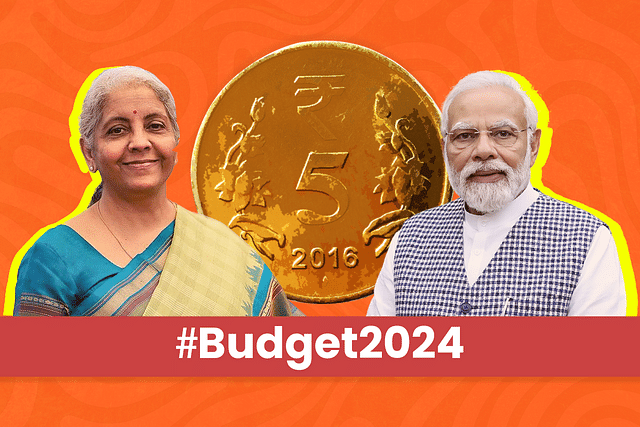Economy
How Modi Government Improved Credibility And Sanctity Of Union Budget, Nirmala Sitharaman's Explanation In 12 Points
- Sitharaman claimed maximising the value and impact of hard-earned taxpayer money.

Nirmala Sitharaman presents interim union budget
Finance Minister Nirmala Sitharaman explained how the Narendra Modi government improved the sanctity and credibility of the Union Budget in the last decade.
Calling the budget "a strategic blueprint for equitable development," Sitharaman said that the government ensured investments in social development and infrastructure.
"We make judicious and efficient use of every rupee collected from our taxpayers and give them a transparent picture of public finances," she said in a post on X on Monday (27 May).
She described the main features of the budget as fiscal prudence, transparency, and inclusiveness. Here are the 12 key highlights from her post:
1. Budget cycle: "Since FY 2017-18, the budget presentation has been shifted to 1 February instead of the last working day in February. It effectively advanced the expenditure cycle by two months."
This also ensures that the entire budgetary exercise, including the legislative process, is completed well before the start of the financial year, improving administrative efficiency.
2. Help to states: "States are now able to plan their own budgets better as they are now aware of details of the Centre’s fiscal plan for the upcoming year.
This reform helps the state governments plan their project financing, counterpart funding, implementation of central projects, and borrowing requirements well in advance."
3. Merger of rail budget: Calling a separate railway budget, a colonial practice, Sitharaman said that its merger helps in presenting a holistic and transparent picture of the Union Government’s financial position.
4. Transparency: She claimed that unlike the UPA government, the Modi government presented transparent budget gaining global trust from international bodies like the IMF and World Bank.
5. Infrastructure budget: Sitharaman said that budget allocations of Ministry of Road Transport and Highways (MoRTH) and Ministry of Railways have been significantly enhanced from FY 2022-23 and 2023-24, respectively.
6. Improved financial discipline: Earlier, three Supplementary Demands for Grants were presented in Parliament, which is reduced to two making "substantive improvements in the process of budget estimation and improved financial discipline."
7. Timely projects: The Delegation of Financial Power Rules 1978 (DFPR) and New Service (NS) / New Instrument of Service (NIS) Financial Limits of 2006 were revised.
This enables timeliness in the implementation of schemes or projects and swift decision-making as administrative ministries and departments are allowed to reallocate savings within certain limits.
8. Contingency Fund helps meeting unforeseen expenditures that arise when the Parliament is not in Session. It was increased from Rs 500 crore to Rs 30,000 in FY 2022.
9. Digital budget: From FY 2021-22, the budget has been digital, and electronic copies of budget documents are distributed to MPs instead of paper copies, making it a greener budget.
10. TSA reform: Treasury Single Account (TSA) reform was introduced in 2017-18, eliminating bulk release of grants to Autonomous Bodies and introduction of 'PFMS-e-kuber' interface for fund disbursement.
"This led to 'just-in-time' release of funds to Autonomous Bodies and lowered the borrowing costs for the Centre and has covered over 3,000 implementing agencies and a total of around Rs 5 lakh crore of Union Budget till FY 2023-24."
11. Scheme-wise CNA: For 221 Central Sector schemes (100% central funding) with an annual outlay of less than Rs 500 crores, a scheme-wise Central Nodal Agency (CNA) was introduced.
This restricted the actual flow of funds to only one level, i.e., CNA. cutting down the account numbers from 60,000 to 894, easing the monitoring and bringing unutilised parked funds to zero.
12. SNA model for states: Each State has to identify and designate a Single Nodal Agency (SNA) for every Centrally Sponsored Scheme (CSS) and has to transfer funds within a stipulated period.
"Effective implementation of the SNA model has brought about greater efficiency in CSS fund utilisation, tracking of funds, and pragmatic and just-in-time release of funds to the States," Sitharaman said.
"The SNA System also significantly reduced the possibility of fund diversion by the State or Implementing Agencies earmarked for a particular CSS," she added.
Support Swarajya's 50 Ground Reports Project & Sponsor A Story
Every general election Swarajya does a 50 ground reports project.
Aimed only at serious readers and those who appreciate the nuances of political undercurrents, the project provides a sense of India's electoral landscape. As you know, these reports are produced after considerable investment of travel, time and effort on the ground.
This time too we've kicked off the project in style and have covered over 30 constituencies already. If you're someone who appreciates such work and have enjoyed our coverage please consider sponsoring a ground report for just Rs 2999 to Rs 19,999 - it goes a long way in helping us produce more quality reportage.
You can also back this project by becoming a subscriber for as little as Rs 999 - so do click on this links and choose a plan that suits you and back us.
Click below to contribute.
Latest